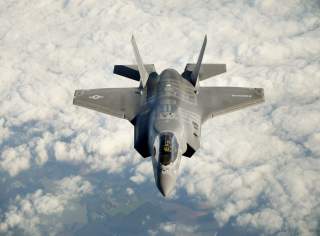Lockheed Martin F-35 Joint Strike Fighters Are Getting Closer and Closer to Russia's Doorstep
Closer and closer.
Operational Lockheed Martin F-35 Joint Strike Fighters belonging to the U.S. Air Force deployed to Europe for the first time in late April.
According to the Air Force, eight of the stealthy single-engine strike fighters deployed to RAF Lakenheath in England as part of the deployment from the 419th Fighter Wing at Hill Air Force Base in Utah. The purpose of the deployment is not only to introduce European NATO allies to the new aircraft and its capabilities, but also to help deter Russia in the East.
“The sovereignty of the skies over NATO nations is paramount,” Gen. Tod Wolters, USAFE-AFAFRICA commander, said on April 19. “This training signifies natural progression of the F-35 program. It allows us the opportunity to demonstrate and obtain the confidence in operational and interoperability characteristics of the system.”
While the deployment is primarily centered around RAF Lakenheath, which will eventually become the first U.S. Air Force base in Europe to permanently host the new jets in the 2020s, the F-35s deployed all over the continent to show the flag. Perhaps the two most prominent deployments were to Bulgaria and Estonia.
As pair of F-35As flew to Estonia on April 25 accompanied by 20 personnel. The small Baltic nation is at the frontline of the current standoff with Russia. Indeed, deployment to Estonia is a particularly potent signal to Moscow. Estonia is a former constituent republic of the Soviet Union itself and its border is less than 100 miles from Saint Petersburg—Russia’s second largest city.
Meanwhile, a pair of F-35s also deployed to Bulgaria—a former Warsaw Pact member that is now part of the NATO alliance. However, while the deployment to Estonia was right on Russia’s doorstep, the Bulgarian deployment is further away. Moreover, the U.S. Air Force routinely conducts many larger-scale exercises in that nation in the form of Thracian Eagle, Thracian Summer and Thracian Star among others. Nonetheless, the F-35As’ visit to Bulgaria was a milestone of sorts.
“We are grateful to our Bulgarian friends for their support in making today possible," Lt. Gen. Richard Clark, 3rd Air Force commander. "Your cooperation helps prepare the F-35 for its invaluable contribution to our alliance. We look forward to many more years of our shared commitment and partnership."
The F-35 seems to be performing adequately on deployment to Europe. One of the benefits of deploying to Lakenheath is that it affords the Air Force an opportunity to get a preview of potential problems that might need to be addressed before the first permanently based F-35s arrive. In the meantime, the local Boeing F-15C Eagle and F-15E Strike Eagle units have the opportunity to learn how to integrate better with the new jet.
“We fight best when we fight together,” Lt. Col. Scott Taylor, a F-15C pilot and the 493rd Fighter Squadron director of operations, said. “We’ve had a lot of synergy in our training. When we come back and talk after missions, we can have that face-to-face interaction and review our tactics. That’s just going to improve the way we fight with the F-35A and has made this an outstanding deployment.”
Eventually, the F-35 will form the backbone of American air power in Europe.
Dave Majumdar is the defense editor for The National Interest. You can follow him on Twitter: @davemajumdar.

